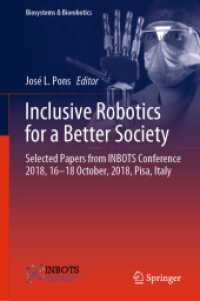Full Description
A Passion for Cooperation is the exciting autobiography of Robert Axelrod, one of the most acclaimed and wide-ranging scientists of the last fifty years. After being recognized by President Kennedy for being a promising young scientist while in high school, Axelrod built a career dedicated to collaborating with business school professors, international relations scholars, political scientists, computer scientists, and even evolutionary biologists and cancer researchers. Fifty years later, he was honored by President Obama with the National Medal of Science for scientific achievement and leadership and his work has been referred to as the gold standard of interdisciplinary research.
Yet Axelrod's autobiography is not just an account of his wide-ranging passion for cooperation. It reveals his struggles to overcome failures and experience the joys of gaining new insights into how to achieve cooperation. A Passion for Cooperation recounts Robert Axelrod's adventures talking with the leader of the organization Hamas, the Prime Minister of Israel, and the Foreign Minister of Syria. Axelrod also shares stories of being hosted in Kazakhstan by senior Soviet retired generals and visiting China with well-connected policy advisors on issues of military aspects of cyber conflict. Through stories of the difficulties and rewards of interdisciplinary collaborations, readers will discover how Axelrod's academic and practical work have enriched each other and demonstrated that opportunities for cooperation are much greater than generally thought.
Contents
Table of Contents
List of Illustrations
Foreword by Douglas Hofstadter
Part I. A Splendid Education
1. Family, Math, and Competitiveness
2. Computers and Modeling
3. Culture and More Math at College
4. Internships on Statistics, Evolution, and National Security
5. Political Science in Graduate School
Part II. Being There
6. Berkeley in a Time of Troubles, 1968-74
7. Walking the Interdisciplinary Walk at Michigan, 1974-
Part III. Cooperation
8. Tournaments
9. Evolution
10. Trench Warfare
11. Responses
Part IV. Self-Organization
12. Minimizing the Strangeness of Bedfellows
13. Social Polarization
14. Belief Systems
Part V. Sex and Cancer
15. The Reason for Sexual Reproduction
16. Cancer as Social Dysfunction
Part VI. Outside the Ivory Tower
17. Opposing the Vietnam War
18. Trying to Reduce the Risk of War
19. Countering Hostile Influence
Part VII. Concluding Thoughts
20. Crossing the Moat
21. Looking Forward
Acknowledgments
Endnotes
List of Illustrations Figure 1. In Oval Office, March 6,1961
Figure 2. The BACH group in the late 1980s
From left to right: Michael Cohen, Robert Axelrod, William Hamilton, Arthur Burks, John Holland, Rick Riolo, Michael Savageau, Carl Simon.
Figure 3. Possible Alignments on the Eve of World War II
Figure 4. Rich Davis, me, Scott Atran, and Safwat Hegazi in Cairo, Oct. 2012
Figure 5. Receiving the National Medal of Science from President Barack Obama, November 20, 2014







